Our briefing on the new Bureau of Justice Statistics numbers spark discussion on Twitter.
by Catherine Cain,
September 18, 2014
On Tuesday, the Prison Policy Initiative released a briefing on the Bureau of Justice Statistics’ national update for 2013, Prisoners in 2013. PPI’s briefing highlighted continuing racial disparities within the prison system and record high prison populations in 14 U.S. states. It also showed that, after three years of decline, the total prison population has increased and disproved any relationship between state crime rates and incarceration rates. After posting some of these highlights on Twitter, we received a variety of excited responses and more twitter traffic than we’ve seen since June.
Here is what a few users had to say:
Liam Johnston succintly tweets:
PPI supporter and board member Heather Ann Thompson:
The Southern Poverty Law Center called our briefing a must read.
Organizer with Milk Not Jails, Brenden Beck, also noted:
A lot of people pulled out their favorite findings from our briefing, including the racial disparity facts:
After learning that 14 individual U.S. states set record high prison populations this past year, many twitter followers also commented on how these individual states– as well as the U.S. as a whole –measure in comparison to other countries. Some commentators revisited statistics that the Prison Policy Initiative published last year, States of Incarceration: The Global Context:
Orleans Public Defender tweets:
Feel left out on all the action? Follow us on Twitter.
Sesame Street's series on incarceration, with videos, activities, and tips for parents, providers, and caregivers
by Bernadette Rabuy,
September 18, 2014
A couple of months ago, John Oliver did a hilarious episode on prisons including a scene in which Oliver sings about prisons with Sesame Street muppets. A few days ago, thanks to a tweet by the Southern Coalition for Social Justice, we got to see another, animated video from the Sesame Street series, “Little Children, Big Challenges: Incarceration.”
It’s a heartbreaking video and also an opportunity to get a glimpse into the life of a child with an incarcerated parent. Along with a series of videos with muppets and real kids’ stories, the Sesame Street toolkit includes activities and tips for incarcerated parents, providers, and caregivers. We agree with John Oliver that it’s great to see Sesame Street addressing mass incarceration, but it’s beyond disturbing that our nation’s failed policies and practices leave more than 2.7 million children with an incarcerated parent.
New report serves as a sobering reminder that state-level criminal justice policy decisions are continuing to ensure that our nation remains the top incarcerator in the world.
by Peter Wagner and Leah Sakala,
September 16, 2014
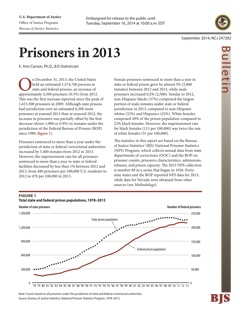 This morning, the criminal justice policy world got a new key metric on mass incarceration in the U.S.: the Bureau of Justice Statistics’ national update, Prisoners in 2013. This report serves as a sobering reminder that state-level criminal justice policy decisions are continuing to ensure that our nation remains the top incarcerator in the world. While the report indicates a few promising improvements, the overall picture is grim.
This morning, the criminal justice policy world got a new key metric on mass incarceration in the U.S.: the Bureau of Justice Statistics’ national update, Prisoners in 2013. This report serves as a sobering reminder that state-level criminal justice policy decisions are continuing to ensure that our nation remains the top incarcerator in the world. While the report indicates a few promising improvements, the overall picture is grim.
Key takeaways from the report:
- Overall, the state and federal prison population increased slightly between 2012 and 2013. Although this is the first overall increase since 2009, the overall prison population has held fairly steady compared to the rapid rise of earlier decades.
- The number of people incarcerated in California increased. In the past several years, in response to a Supreme Court mandate, California’s prison population declined enough to pull the national incarceration rate down.
- While the total number of people incarcerated grew, the country as a whole grew faster, so there was a slight decline of less than half of a percent in the incarceration rate. This change is far too small to impact the results of our June report States of Incarceration: The Global Context finding that every state in this country uses incarceration far more than most of the world.
Here’s the good news:
- For the first time, the federal prison population reported a decline. Over the last decade, the federal Bureau of Prisons had been reporting a growth rate more than 4 times faster than the states, so this is a significant change in direction.
- Some states continue consistent declines in their prison population: New York and New Jersey have declined populations every year but one since 1999, Hawaii has declined for eight years in a row, and South Carolina 4 years in a row.
- 21 states reported declines in their sentenced prison population
- 10 states that had reported growing prison populations for both 2011 and 2012 reported a decline in 2013.
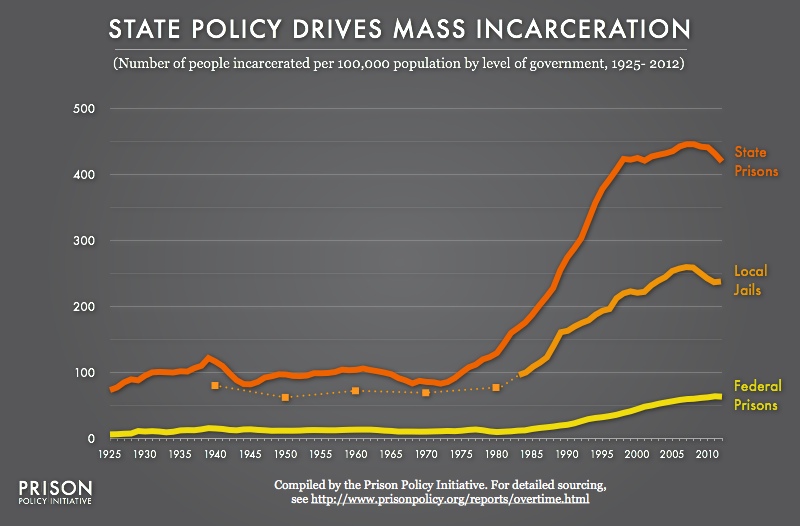 Ending the U.S. experiment with mass incarceration requires us to focus on state policy because individual states are the most active incarcerating bodies in the nation. Graph from our May 2014 report, Tracking State Prison Growth in 50 States shows the number of people (per 100,000 national population at that time) that is confined in state, local and federal correctional facilities from 1925 to the present. State prisons are the largest part. (See larger or as raw numbers.)
Ending the U.S. experiment with mass incarceration requires us to focus on state policy because individual states are the most active incarcerating bodies in the nation. Graph from our May 2014 report, Tracking State Prison Growth in 50 States shows the number of people (per 100,000 national population at that time) that is confined in state, local and federal correctional facilities from 1925 to the present. State prisons are the largest part. (See larger or as raw numbers.)
And the bad news:
- Reversing 3 years of declining populations, the total prison population increased.
- The number of admissions to prison increased and the number of releases fell in 2013. Each are a bad sign and the combination of both is particularly harmful.
- Racial disparities continue to constitute the defining characteristic of the prison system. For example, 3% of Black males of all ages are currently incarcerated in state or federal prisons. This is a rate 6 times higher than white males.
- 14 states hit new record high prison populations in 2013: Arizona, Arkansas, Indiana, Kansas, Minnesota, Missouri, Nebraska, North Dakota, Ohio, Oklahoma, Oregon, Tennessee, Utah, and Wyoming.
- Texas, one of the states with the highest incarceration rates and which had a much heralded “reform” of its prison population, saw an increase in both its total prison population, its sentenced population, and its incarceration rate.
And remember, this new report from the Bureau of Justice Statistics is just talking about the state and federal prison population, which form just a portion of the much larger incarceration pie of which jails are the next largest piece:
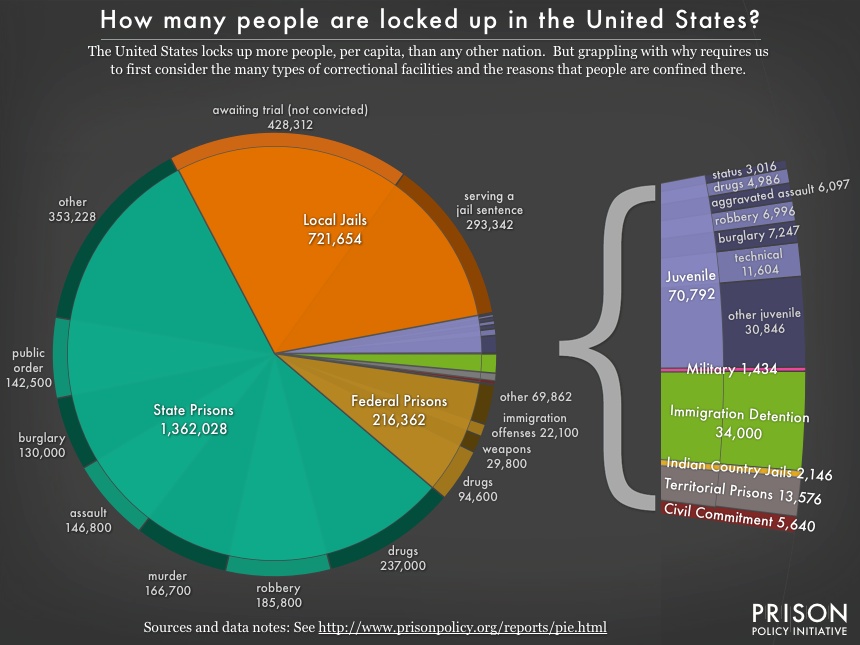 Lets not forget that people incarcerated in prison are just a portion of the people under control of the correctional system. There are jails, juvenile prisons, military prisons, immigration detention, Indian Country jails, territorial prisons, civil commitment, plus probation and parole of which there are 3,981,090 adults on probation, and 851,662 adults on parole.
Lets not forget that people incarcerated in prison are just a portion of the people under control of the correctional system. There are jails, juvenile prisons, military prisons, immigration detention, Indian Country jails, territorial prisons, civil commitment, plus probation and parole of which there are 3,981,090 adults on probation, and 851,662 adults on parole.
For more information about ending mass incarceration in your state, see our state profiles.
by Peter Wagner,
September 12, 2014
While New York State’s prison population has been dropping overall as a result of number of significant reforms, one group being left quite literally behind is the elderly. From 2000 to 2013, the number of people 50 years of age or older incarcerated in New York State prisons has doubled.
A campaign to reduce the number of elderly and infirm people in New York State prisons is being led by Muhajid Farid, lead organizer of the Release of Aging People in Prison campaign.
As the campaign’s website says:
RAPP focuses on this growing population of aging people in prison, many of whom are long-termers convicted of serious crimes. Many of these human beings have transformed their lives and developed skills and abilities they lacked before incarceration. They could be released from prison with no threat to public safety. Yet many are denied release, often for political reasons, and needlessly remain imprisoned into old age. These elders could be released if current mechanisms such as parole and compassionate release were correctly utilized; we also support legislation like the S.A.F.E. Parole Act to reform the parole system and increase the number of releases.
I got to spend some time with Farid at a conference in July, and offered to use our knowledge of the New York State prison system’s data to make a graph showing the problem. With the help of PPI summer research associate Sarah Hertel-Fernandez, we plotted the change in New York State’s prison population by age from 1996 to the present. What’s notable is that New York’s much-heralded prison population decline is confined solely to the population of people under 50. The elderly are being left behind.:
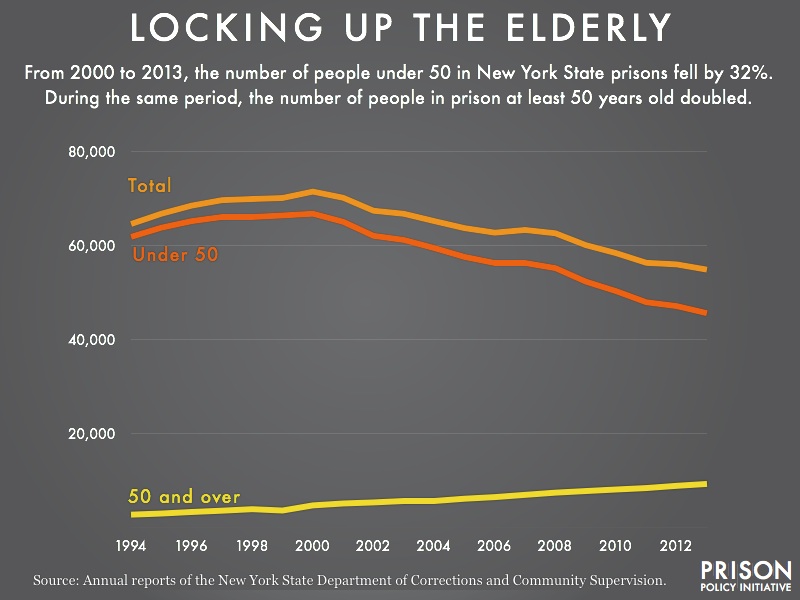
At that same conference Leah Sakala and I had a chance to interview Farid:
If you are in New York City on Sunday afternoon, Farid will be among the speakers at a Brooklyn Museum event Discussion: “What’s Age Got to Do with It? Incarcerating Children and the Elderly”.
Update September 15, 2014: Added the years 1994 and 1995 to the graph.
Note: We’d like to extend this graph further back in time. If you can help us locate the January 1 population reports from the New York State prison system for the years 1993, and 1991 and prior, please contact us.
SB 1135 is a no-brainer. Governor Brown, end sterilization abuse in CA today.
by Bernadette Rabuy,
September 12, 2014
For the past few years, California has been a well-known site of criminal justice reform. Beginning in 2006 and accelerating in 2009, the California prison population declined rapidly. In 2012, in response to a Supreme Court order to reduce unconstitutional prison overcrowding, Governor Brown signed the realignment law, which shifted incarcerated individuals with lower-level offenses from state prisons to county jails. While the results have been mixed, some counties have used the realignment law as an opportunity to adopt and experiment with alternatives to incarceration.
Yet, what is likely less well known is California’s shameful legacy of eugenics. Last year, the Center for Investigative Reporting found that from 2006 to 2010 the California Department of Corrections and Rehabilitation sterilized nearly 150 incarcerated females, permanently ending their chance of future pregnancy and doing so without required state approval.1 Doctors in California prisons pressured incarcerated females—especially those who had served multiple prison terms—to undergo sterilization procedures. When asked about the cost of the procedures, Dr. James Heinrich, an OB-GYN at one of California’s prisons who has been accused of pressuring females to agree to sterilizations, told the Center for Investigative Reporting, “Over a 10-year period, that isn’t a huge amount of money compared to what you save in welfare paying for those unwanted children – as they procreated more.” While Dr. Heinrich claims he performed the procedures for the health and safety of the incarcerated females, the females who were under his care say otherwise. One woman, Kimberly Jeffrey, said a doctor at Valley State Prison pressured her while she was sedated and strapped to a surgical table for a C-section in 2010. Clearly, eugenics is not a practice of the past.
On August 25, we at Prison Policy Initiative sent a letter to Governor Brown in support of SB 1135 (Senator Hannah-Beth Jackson), which is currently sitting on his desk. SB 1135 will clarify the prohibition of sterilizations for the purpose of birth control on incarcerated individuals and will create greater safeguards to ensure that only sterilizations that are medically necessary will be performed. This includes annual reporting of sterilizations performed, broken down by race, age, method, and medical justification. We believe that, whether an individual is incarcerated or not, she should have the right to make her own choices regarding her reproductive life. Justice Now, an Oakland-based organization, has been at the forefront of the movement to end sterilizations for the purpose of birth control in California prisons. Through Justice Now’s leadership, SB 1135 has unanimously passed the California legislature. It now sits on Governor Brown’s desk, and we urge him to end sterilization abuse in California today.
Dallas County tells Securus: No we won't end visiting hours at jail and require expensive video visitation instead.
by Peter Wagner,
September 9, 2014
Today the Dallas County Commissioners Court refused to approve a proposed contract with prison telephone giant Securus. The contract would have required the jail to end visiting hours and instead force families to pay for expensive video visits via computer.
After County Judge Clay Jenkins courageously spoke out against the proposed contract, a movement quickly came together, coordinated by Texas CURE, to urge the other County Commissioners to support Judge Jenkins. (In Texas, the county legislature is called a “Commissioners Court” and the person elected county-wide to be the county’s chief administrator is called the County Judge. For more, see this wikipedia article. )
As I argued in a New York Times Room for Debate feature, prison and jail video communication has the potential to offer additional avenues for critical family communication, but charging unconscionable sums and banning free in-person visits is a step in entirely the wrong direction.
Today, after several hours of eloquent and unanimous testimony and the submission of more than 2,000 petitions from SumOfUs and other petitions collected on NationInside and Change.org, we beat back this horrible proposal!
Now things got a little complicated procedurally, but this was a big, albeit interim, win. The Commissioners Court didn’t approve Judge Jenkins’s order to reject this contract and start over with completely new criteria that would prioritize getting the best service possible for both families and Dallas County, but the Court soundly rejected the two most critical parts of the proposed contract: the ban on in-person visitation and the collection of commissions for video visitation. (At least one commissioner supports commissions in the phone context, but many are opposed there as well.)
As I understand it, the Commissioners Court voted to propose changes to the contract to:
- protect in-person visitation
- renounce the commission on video visitation
- seek clarity on other details, including the number of video visitation terminals that would be provided.
The County proposed to, at next week’s meeting, approve a new request for “Best and Final Offers” based on the county’s new and improved understanding of the importance of keeping families together, and then to send these new requirements out to all of the bidders on the contract to solicit new proposals.
Obviously, some details remain to be worked out, but what seemed clear to us watching the video of the hearing is that the Commissioners Court now understands that in-person visitation is important and that it shouldn’t let Securus — or any vendor — entice the county into breaking up families just to make an extra buck.
Stay tuned for how we can ensure that Dallas finalizes a contract that supports families and benefits all residents of the County, and stay tuned for our forthcoming report on the video visitation industry.
by Peter Wagner,
September 9, 2014
Later this morning, Dallas County Texas will vote on a new telephone contract with Securus that will also ban free in-person visits and require families to pay for video visitation instead.
There have been two good stories this week:
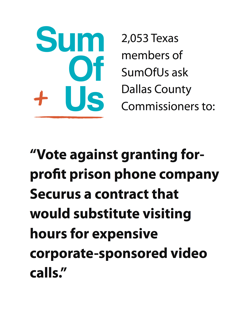
With the vote scheduled for this morning, our friends at SumOfUs collected 2,053 petitions from their Texas members in under 12 hours yesterday urging the county to reject a “contract that would substitute visiting hours for expensive corporate-sponsored video calls.”
To our friends in Texas, good luck today!
Where 96% isn't 96% and clients aren't clients.
by Leah Sakala,
September 2, 2014
For most companies, forking over 96% of revenue would be a disaster. But prison and jail telephone companies don’t operate in a normal market by any stretch of the imagination.
In a recent letter to the Federal Communications Commission (FCC), prison and jail phone company CenturyLink explained that it won its contract with the Escambia County, Florida, jail by promising to kick 96% of call revenue back to the jail. To make up for this loss, CenturyLink explains, the company relies on “ancillary fees to cover costs that otherwise could not be recovered in per-minute rates after deducting the County’s required commissions.” (For more on how commission payments and ancillary fees go hand in hand, check out our second report on the industry.)
Now, a 96% kickback/commission must sound very attractive from a sheriff’s point of view. But, as Pay-Tel founder Vince Townsend explained at last month’s FCC workshop, hidden fees can put sheriffs at a major disadvantage. Because the fee revenue is kept separate from the calling revenue, fee revenue lies entirely outside of the commission system. In other words, the only reason why CenturyLink can promise to kick back 96% of the calling revenue to Escambia County is because the company is collecting 100% of the fee revenue. And while CenturyLink claims to have disclosed all its ancillary fees as part of the contract negotiation process, corporate transparency is the exception in this market, not the norm.
Mr. Townsend pointed out that even a sky-high commission percentage turns out to bring in far less money to a correctional facility once the telephone company has kept the fee revenue for itself. Using $100 of gross revenue as an example, he explained:
I couldn’t do this to my clients*…. If I was scraping 60% of the money off the top [in fees] before I paid them commissions, I couldn’t do that. I respect them too much to do that because it is total deception to go in to somebody and say, “Oh, I’m going to give you 80%!” Well, what’s the 80% on? It’s really on $40. What’s 80% of $40? [The actual commission percentage is] 32%.
But one day they’ll wake up [about how hidden fees reduce commissions], and when they do I’m glad I’m on my side and not doing that.
Now, from the companies’ perspective charging high rates and hefty fees sounds like a profitable way to exploit a literally captive market. It turns out, however, that using some of the techniques found in normal markets can be good for business *and* good for families and communities. The experience of states like New York has found that making phone calls more economically accessible stimulates business. Other prison and jail communications companies are choosing strategies like offering discounts on high-volume holidays to introduce their services to new customers, and lowering fees to increase use of their services.
These normal-market-type tactics are unfortunate anomalies in the prison phone industry, but the movement for fair prison and jail communication policy is making steady progress. The FCC’s first order ruled that the prison and jail phone service fees must be based on the actual cost of doing business, which does not, the order emphasized, include handing over the majority of calling revenue to prison and jail systems. On the state level, places like Alabama are also taking statewide action to rein in the industry’s fees and kickbacks.
Be sure to stay tuned to see how the FCC and states’ next steps keep the ball rolling towards a fairer and more just prison and jail phone market.
*Just to clarify, Mr. Townsend refers to the correctional facilities as his “clients,” but of course who’s paying all the money that is turned into kickbacks and fee revenue? The families of incarcerated people.








